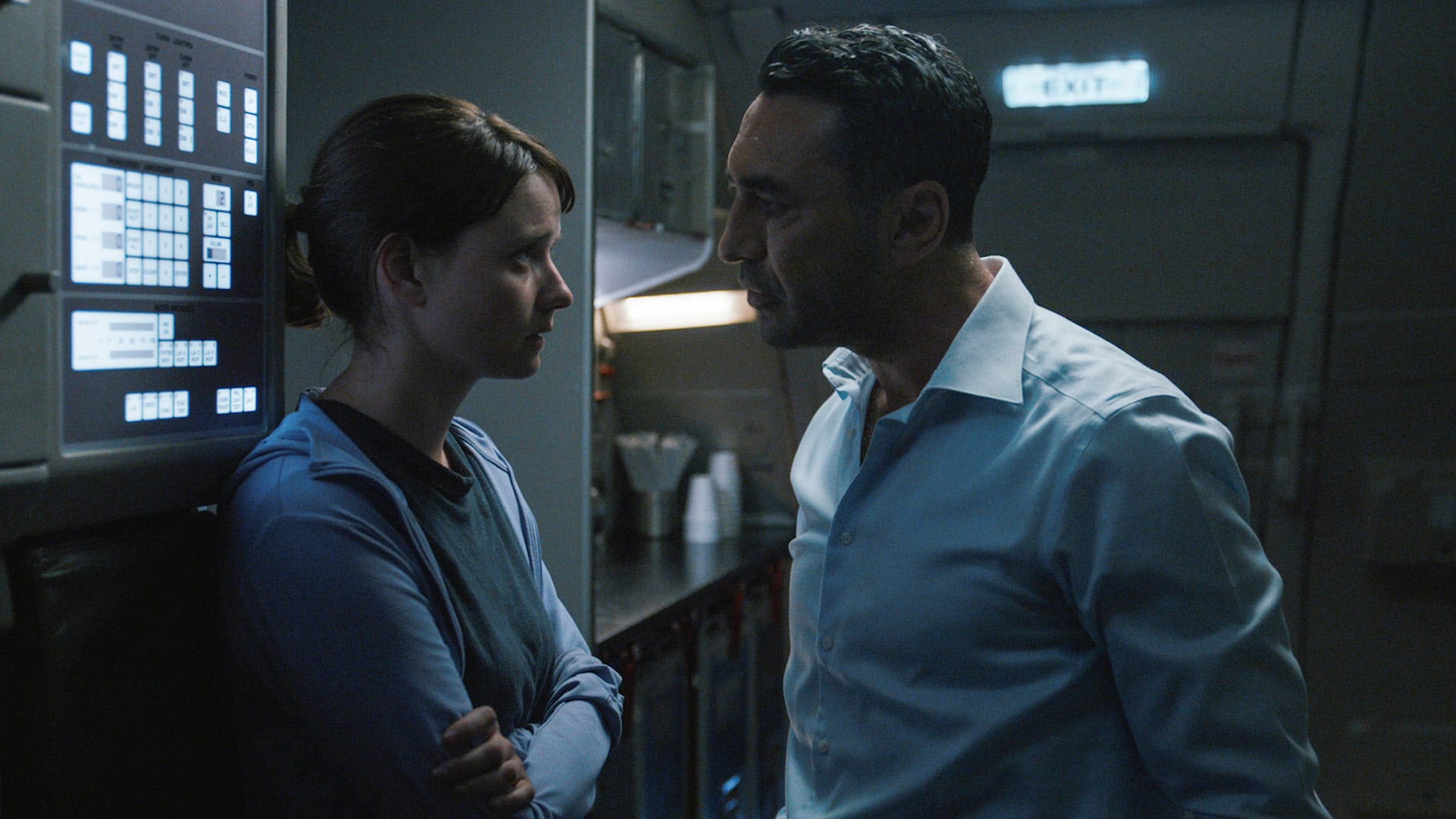Into the Night: When Sunlight Becomes Humanity's Deadliest Enemy

Netflix's "Into the Night" delivers one of the most uniquely terrifying apocalyptic premises ever conceived: a world where exposure to sunlight means instant death. This Belgian thriller, which premiered in May 2020, transforms our most fundamental life-giver into an unstoppable executioner that follows Earth's rotation with mathematical precision.
The sun turns killer overnight
Imagine boarding a red-eye flight to Moscow, settling into your seat, only to have an armed NATO soldier storm the plane screaming that everyone outside is dead and you must take off immediately. Within minutes of this chaotic hijacking, passengers discover the unthinkable—the sun has undergone a mysterious cosmic event, and its radiation now kills all living organisms instantly upon exposure. This is the heart-pounding opening of "Into the Night," and from this moment forward, the only way to survive is to keep flying west, perpetually chasing the darkness and outrunning the sunrise.
The show's creators explain this catastrophe as a "solar polarity reversal"—the sun has essentially become an electromagnetic radiation machine that destroys organic matter at the cellular level. Unlike typical apocalyptic scenarios involving zombies or viral outbreaks, this threat is environmental and inescapable. The radiation doesn't burn or char; instead, it completely breaks down DNA and cellular structures within seconds of exposure, leaving no trace of the victims behind. Water and thick barriers can provide temporary protection, but ultimately, staying in darkness is the only guaranteed survival method.
Racing against sunrise in a hijacked plane
The core survival mechanism drives the show's relentless tension: the survivors must maintain a westward flight path, constantly calculating fuel consumption, landing opportunities, and the inexorable advance of daylight. Led by co-pilot Mathieu and former military helicopter pilot Sylvie, the group faces an impossible logistics puzzle—commercial aircraft weren't designed for indefinite flight, and every landing for fuel or supplies risks exposure to the deadly dawn.
The first season focuses on reaching an underground NATO bunker in Bulgaria, while the second season shifts to the survivors attempting to reach the Svalbard Global Seed Vault in Norway, searching for a permanent solution. The show excels at depicting realistic resource limitations: fuel calculations become life-or-death mathematics, food supplies dwindle, and landing rights at darkened airports become negotiation nightmares. Characters develop increasingly desperate strategies, from using underground facilities and tunnels to timing supply runs with surgical precision during the brief twilight periods.
International tensions at 30,000 feet
The confined space of an aircraft becomes a pressure cooker for human drama, amplified by the show's deliberately multilingual cast speaking French, English, Turkish, Italian, Russian, Arabic, and Spanish. This isn't just aesthetic diversity—language barriers and cultural misunderstandings create genuine conflict as passengers from different backgrounds must cooperate to survive. A Turkish mechanic clashes with a Russian thief, while an Italian NATO soldier's military mindset conflicts with civilian passengers' democratic impulses.
Key characters emerge through crisis: Terenzio, the soldier who hijacked the plane to save everyone; Ayaz, a mysterious Turkish man with a violent past seeking redemption; Ines, a social media influencer who discovers unexpected leadership qualities; and Rik, an airport cleaner whose technical knowledge becomes invaluable. Each episode opens with character flashbacks that reveal hidden depths—Rik's innocent reason for traveling to Moscow will simultaneously warm your heart and break it, while the fierce mother-son dynamic shows how far a parent will go to protect their child.

The show deliberately avoids clear heroes and villains—survival brings out both the best and worst in each character, with moral compromises becoming increasingly necessary as resources dwindle. Characters you initially dislike may become your favorites, while those who seem heroic reveal devastating flaws under pressure.
The science debate that makes it more engaging
The scientific premise sparked intense debate among viewers, which became part of the show's appeal. While some praised the creative concept of weaponized solar radiation, others questioned the logistics—how could a helicopter pilot suddenly fly a commercial aircraft? Why doesn't the radiation penetrate thin airplane walls? The show's creators, adapting Polish author Jacek Dukaj's novel "The Old Axolotl," deliberately chose dramatic tension over scientific accuracy. This decision works brilliantly because it keeps the focus on human responses to crisis rather than getting bogged down in technical explanations that might slow the relentless pace.
Standing apart in the apocalyptic crowd
Released during the peak of zombie-dominated survival shows, "Into the Night" carved out a unique niche. Unlike "Sweet Home" or "All of Us Are Dead" with their monster-filled worlds, or "Kingdom" with its historical zombie plague, this series presents an enemy that can't be fought, negotiated with, or cured. The sun—humanity's most fundamental life-giver—becomes an unstoppable executioner that follows a predictable but inescapable schedule.
The show shares DNA with environmental disaster narratives like Denmark's "The Rain" but distinguishes itself through its real-time survival mechanics. Every episode accounts for time zones, fuel consumption, and the Earth's rotation with surprising attention to detail. This grounded approach, combined with the 38-minute episode format, creates a binge-worthy experience that viewers described as "nerve-wrackingly addictive."
Behind the scenes of perpetual darkness
As Netflix's first Belgian production, "Into the Night" operated on a modest budget that forced creative solutions. Directors Inti Calfat and Dirk Verheye used practical locations across Belgium, transforming real aircraft and military facilities rather than building elaborate sets. The sunlight death scenes relied primarily on suggested horror—shadows creeping across surfaces, characters' terrified reactions, and strategic cutaways—rather than expensive CGI effects.

Creator Jason George, known for his work on "Narcos" and "Scandal," brought a documentary-style realism to the production. The international cast often improvised dialogue in their native languages, adding authenticity to the cultural tensions. The production team consulted with aviation experts for the flight sequences but admitted taking "creative liberties" with the solar radiation science, prioritizing emotional truth over technical accuracy.
Themes that resonate beyond the apocalypse
Beneath its high-concept premise, "Into the Night" explores surprisingly deep themes about human nature under extreme pressure. The show examines how quickly social hierarchies dissolve when traditional authority structures fail—should the group follow the military officer who saved them, the pilot who knows how to fly, or establish democratic decision-making? These power struggles reflect real-world debates about expertise versus democracy in crisis management.
The series also tackles environmental anxiety in a unique way. Unlike climate change narratives that unfold over decades, this catastrophe is immediate and irreversible. Characters must accept that the world they knew is gone forever, processing grief while fighting for survival. The show's greatest achievement lies in depicting how ordinary people—not scientists or soldiers—might actually respond to an extinction-level event: with panic, denial, surprising ingenuity, and ultimately, a desperate hope that somewhere, somehow, a solution exists in the darkness ahead.
The uncertain future of Season 3
Unfortunately, fans hoping for a third season are stuck in their own kind of darkness. As of late 2025, Netflix has neither renewed nor cancelled "Into the Night," leaving the series in an indefinite limbo. This silence is particularly frustrating given that Season 2 ended in September 2021 with a major cliffhanger—Horst and Laura's discovery of a live rat that, for unknown reasons, survived direct sunlight exposure, suggesting a potential biological solution to humanity's crisis.
The lack of official word from Netflix for nearly four years isn't necessarily a death sentence, but it's not encouraging either. Industry insiders suggest that if the show were to return, the earliest realistic release date would be 2025 or 2026, accounting for production schedules and the time already passed. The show's moderate budget and international success, including spawning the Turkish spin-off "Yakamoz S-245" in 2022, could work in its favor for renewal discussions.
What makes the wait particularly agonizing is that Season 2 clearly set up future storylines. This discovery of the surviving rat opens possibilities for developing protective measures against solar radiation, while unresolved character arcs and the question of whether other survivors exist worldwide leave plenty of narrative territory to explore. If Netflix does greenlight Season 3, fans can likely expect another six-episode format, maintaining the tight pacing that made the first two seasons so bingeable.
For now, viewers can only keep checking Netflix's renewal announcements and hope that "Into the Night" doesn't become another casualty of the streaming service's notorious habit of cancelling shows despite passionate fanbases. The series proved that European productions could capture global audiences with universal themes—now it just needs Netflix to give it one more chance to reach its conclusion.
